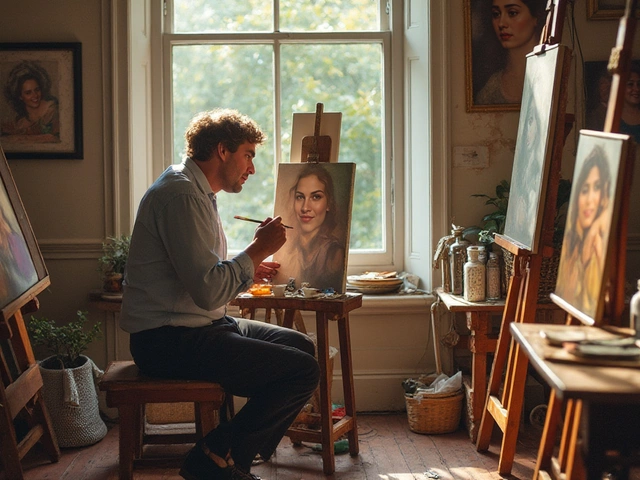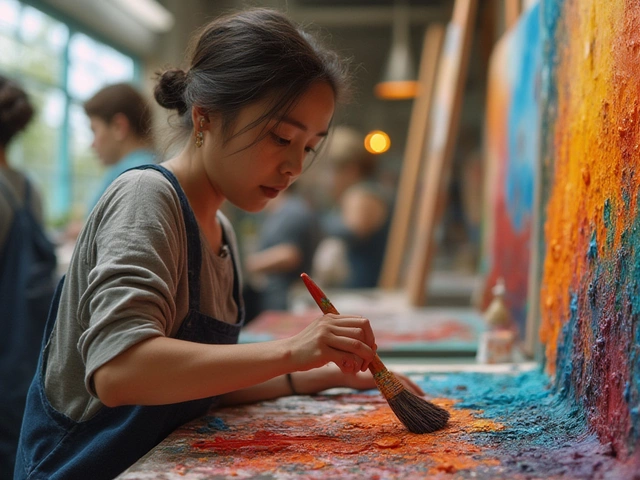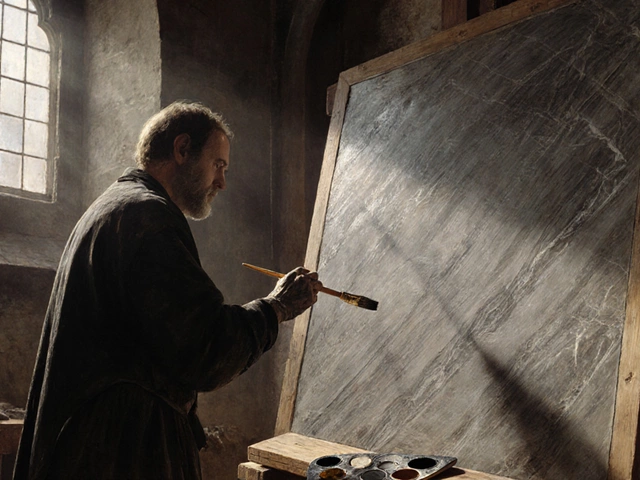For many artists, the notion of selling art prints is a ponderous decision that can greatly influence their creative journey. More than just a secondary revenue stream, art prints open up a realm where creativity and commerce intersect, allowing artists to reach new audiences without forfeiting the allure of their originals. The world of art prints is vast, varied, and continually evolving, requiring a keen understanding of the art market landscape.
Art prints possess a unique charm, offering the beauty of an original piece at a fraction of the price, which allows artists to connect with a diverse audience. The potential of prints lies in their accessibility and appeal, making art ownership a reality for many who might otherwise never afford an original. However, launching into the print market demands more than just replication of artwork – it necessitates a blend of strategic thinking, quality control, and market savvy.
- Benefits of Selling Art Prints
- Understanding Market Demand
- Pricing Strategies for Art Prints
- Ensuring Quality and Authenticity
- Promotional Tips for Artists
Benefits of Selling Art Prints
The concept of selling art prints offers a multitude of advantages that are crucial for any artist to contemplate, particularly in today's diverse art ecosystem. One of the most compelling benefits lies in the potential for increased artist income. Unlike original artworks, which are singular and often come with a substantial price tag, art prints make it possible to sell the same image to multiple buyers, thereby maximizing the revenue potential from a single creation. This ability to earn repetitive income from a well-loved piece gives artists financial stability and encourages the creation of series that resonate with different buyer segments.
Reaching broader audiences is another essential advantage of offering art prints. In the traditional art market, the price of original works can limit the number of potential collectors. By providing affordable prints, artists can democratize their art, making it accessible to a more extensive diversity of people who admire the work but might not be ready or able to invest in an original. This wide reach is particularly beneficial when one’s goal is to gain market visibility, and the increased exposure can lead to new opportunities and networks.
The flexibility in reproduction also allows artists to explore different mediums and formats without the risk of creating an original piece that might not sell. This is significant in terms of creative freedom, providing artists with the luxury to experiment and refine their unique style over time. The knowledge that a popular piece can be reproduced without diminishing its value means artists can take bolder creative risks without the typical pressures that come with creating originals.
A key component of success in selling prints is mastering the balance between quality and quantity. As noted by respected gallerist Sirena Williams, who once said, "Prints allow the artist to reach the world, as long as the integrity of the work is retained."
Prints allow the artist to reach the world, as long as the integrity of the work is retained. – Sirena WilliamsMaintaining a high standard of print quality ensures that an artist's reputation remains intact, attracting further patronage and establishing trust with collectors.
Additionally, art prints come with the precious benefit of time management. Instead of dedicating countless hours to create multiple original pieces, artists can devote themselves to a limited number of originals while simultaneously generating prints. This efficient use of time allows for more productive and creative output, leaving room to explore new ideas and concepts without getting bogged down by the demands of producing singular works of art constantly.
The ability to leverage digital technologies further enhances the attractiveness of selling prints. With the advancements in digital printing and online marketplaces, artists have numerous platforms at their disposal to showcase their work globally. Platforms like Etsy, Society6, and Redbubble offer artists a streamlined way to handle logistics – from printing and packaging to shipping – allowing them to focus on the core activity of creating art. This democratization of the art selling process is revolutionary, as it places control directly in the hands of artists, eliminating traditional gatekeepers.
Understanding Market Demand
Diving into the realm of selling art prints requires a deep comprehension of market demand, which can significantly affect an artist's success. Artists must first gauge the interests, trends, and fluctuations within the art market to ascertain what buyers are seeking. This involves not just an understanding of the existing market but also predicting potential shifts in consumer tastes. Art buyers today are influenced by myriad factors, including contemporary trends, economic conditions, and even cultural movements. By examining these variables, artists can strategically tailor their offerings to align with market desires.
Exploring current art market trends is crucial. For instance, emerging themes like sustainability and digital art have driven buyers' interests towards eco-friendly materials and NFTs. Observing such trends helps artists decide what type of art prints to create and offer. While an artist's creative intuition is invaluable, market research provides a solid foundation for understanding what types of art are gaining popularity. Attending art fairs, exhibitions, and engaging with online art communities offer insights into trending topics that resonate with audiences, paving the way for well-informed decision-making.
According to research from Art Basel and UBS, "The global art market saw a 22% increase in sales in 2021, reflecting a bounce back from the effects of the pandemic, with online sales representing 20% of the total."
Moreover, audience demographics play a pivotal role in market demand. Young collectors, for example, often prefer edgy, contemporary styles or pieces that make a bold statement, aligning with their lifestyle and personal identity. Conversely, more traditional collectors might value classic styles or prints that elevate timeless themes. Recognizing these distinctions enables artists to effectively target their offerings, ensuring they reach those most likely to purchase their work. Platforms like Instagram and Pinterest have become powerful tools for artists, using these platforms strategically broadens their exposure to larger and potentially untapped markets.
Understanding pricing strategies is another aspect of market demand. Setting the right price requires an awareness of competitors’ pricing while factoring in the uniqueness and potential mass appeal of one's art prints. Market surveys and feedback can guide artists in evaluating how their pricing stands in relation to the perceived value of their work. Consideration of the costs involved in print production, marketing, and distribution also plays an integral role. Ensuring the price matches the market expectations without undervaluing the artistic endeavor lays the groundwork for success.
Niche markets present additional opportunities when it comes to art print sales. Artists equipped to identify and cater to niche interests can often find dedicated audiences eager and willing to invest. Whether it’s prints that cater to fans of a particular genre, like fantasy or science fiction, or art that holds cultural significance, niching down requires an artist to tailor their message and medium to attract specific segments of the market. This specificity can often result in more loyal and engaged followers.
Finally, international markets should not be overlooked. The demand for art prints varies worldwide, with different regions showing distinct preferences. Artists should consider the logistics of shipping and currency exchange when targeting international buyers. This can be facilitated by understanding cultural nuances and local art trends, and might even involve collaborations with international galleries or platforms that showcase diverse artists. Mapping out a global strategy can enhance reach and solidify an artist's position in the increasingly interconnected world of art sales.

Pricing Strategies for Art Prints
Deciding on how to price art prints is a nuanced endeavor, stitched together by both the artist's aspirations and the market's pulse. A common misconception is to take cues solely from the cost of production. While this is a starting point, it is far from the full picture. Artists should consider various factors including the print size, edition size, the reputation of the artist, and the target market's willingness to pay. Understanding where your work sits within the spectrum of art prints requires a blend of introspection and savvy market research.
One effective method of determining price is by using a cost-plus approach, where artists calculate the cost of materials, production, and labor, then add a margin for profit. But more critical is understanding the demographic you intend to cater to. Are they high-end collectors or first-time buyers? This insight greatly informs how much you can reasonably charge. In the words of art business writer Alan Bamberger, "Knowing your market is as important as knowing how to make your art."
Pricing has little to do with the quality of art itself but more to do with the market dynamics and perceived value, Bamberger suggests.
Exploring different pricing brackets through limited editions can draw in a wider audience. Limited editions, capped at a specific number, can create scarcity—a psychological trigger that often justifies higher prices. This tactic is not only lucrative but also instills a sense of exclusivity and ownership among buyers who are willing to pay more for something they perceive as rare.
| Edition Size | Price Range (USD) | Target Audience |
|---|---|---|
| Open Edition | $20 - $100 | Entry-level buyers |
| Limited Edition (50-100) | $100 - $500 | Intermediate collectors |
| Ultra Limited Edition (10-50) | $500+ | Serious collectors |
Artists should also consider offering different formats and sizes, from postcard-sized prints to larger wall pieces. This strategy not only broadens your reach across different budget types but also maintains accessibility without diluting the value of your art. Keep in mind that the quality of the print matters tremendously. Invest in high-quality printing techniques and materials to ensure longevity and vibrancy in your prints, as this will enhance buyer satisfaction and justify higher prices.
To encapsulate the practice of selling art prints, embrace the balance between artistic integrity and business acumen. Experiment with prices, gather feedback, and don't shy away from revisiting your strategies as your art and renown evolve. The journey of pricing is a dynamic one, and when done thoughtfully, it not only boosts sales but also amplifies your art's reach and appreciation.
Ensuring Quality and Authenticity
In the vibrant arena of art prints, maintaining high-quality standards and authenticity is paramount. Artists stepping into this realm must recognize that the reproduction of their art entails meticulous attention to detail. Each print should be a true representation of the vividness and intricacy of the original work. It's not just about replicating art onto paper; it's about preserving its soul and meaning. Many successful artists recommend employing high-end printing technology like giclée, which ensures that every hue and nuance is accurately portrayed, offering collectors a piece they can treasure for its fidelity to the original.
Moreover, artists must engage in rigorous quality control processes. Small details, such as the texture of paper used and the precision of color alignment, can significantly impact the perception of a print. This is where collaboration with experienced print studios comes into play. These establishments not only possess the expertise to handle artworks delicately but also provide advice on which materials best suit different styles of art. By investing in superior materials, artists can elevate their prints from mere copies to possessions that hold value and admiration.
Authenticity: The Signature of Trust
Authenticity remains a cornerstone of selling art prints. To distinguish their works in a crowded market, artists must infuse a sense of credibility into their prints. Adding certificates of authenticity is one practical method artists employ. These certificates serve as a testimony to the buyers that the prints are genuine reproductions authorized by the artist. Including information such as the number of the edition, the print's title, and the artist's signature transforms a mere print into a covetable piece of art history.
Limiting editions of prints is another strategic advantage. By creating scarcity, artists enhance a print's value and desirability. Collectors are naturally drawn to the uniqueness of limited editions, which are seen as more prestigious and potentially more valuable in the future. This practice also fosters a personal connection between the artist and the collector, as each limited edition becomes a part of the artist's evolving narrative.
"In the world of prints, it's the story behind the canvas that sets a simple piece apart from a collector's treasure," said renowned art critic Jonathan Keats in Art & Culture Magazine.
Ensuring quality and authenticity doesn't merely protect an artist's reputation; it enriches their entire body of work by establishing trust with art enthusiasts. Collectors who purchase prints are looking for a piece of the artist's vision that feels personal and genuine. Thus, artists investing in quality and authenticity are not just safeguarding their art; they are honoring the relationship between creator and admirer, one print at a time.

Promotional Tips for Artists
For artists diving into the world of selling art prints, effective promotion can be the key to unlocking potential markets and driving sales. To get started, it's crucial to understand the platforms through which you can showcase your work. Social media, for instance, has transformed how artists connect with their audience. Instagram, known for its visual-centric approach, allows artists to display their journey, from sketch to final print. It's not just about posting a finished piece; it involves sharing the story behind each creation, which captivates followers and builds a personal connection.
Create consistent content that aligns with your artistic voice and highlights the affordability and appeal of art prints. Employing hashtags specific to your niche can increase your reach, making it easier for potential buyers to find your work. Engaging with followers by responding to comments and hosting live Q&A sessions can further deepen relationships, encouraging community growth. Collaborations with other creators can also extend your reach, introducing your work to new audiences who may fancy the idea of owning a print from a joint effort.
Besides social media, consider investing in a professional-looking website that serves as your virtual gallery. Here, you can provide detailed information about each piece, including its inspiration, dimensions, and materials used. Remember to keep it updated with new creations to keep regular visitors coming back. Make sure your site is optimized for SEO to ensure your art prints appear prominently in search engine results when potential buyers search for them. Offering brief interviews or blog posts about your creative process can add an authentic touch to your site, fostering greater interest.
To incentivize purchases, run limited-time promotions or bundle deals. Encouraging urgency can be highly effective in driving quicker purchase decisions. For instance, offering a limited edition run of a print with a signed note can transform a casual browser into a committed buyer. Always collect and maintain an email list of interested customers to keep them informed of new releases and exclusive offers. Regular newsletters can serve as a gentle reminder of why they admired your work in the first place.
Consider attending local art fairs or pop-up exhibitions. These events provide a unique opportunity to interact with potential buyers face-to-face, offering a personal touch that online marketing cannot replicate. Having a physical presence allows patrons to see the quality of your prints up close, which can be a strong selling point. As cited by Charlotte Bazely, a well-known curator,
“The tactile experience of seeing and feeling an artist’s work in person can fundamentally change how we perceive its value.”Such experiences can turn casual interest into an immediate purchase, especially when coupled with a compelling backstory.





